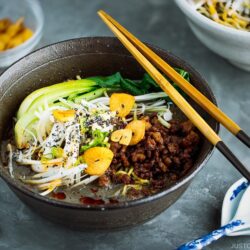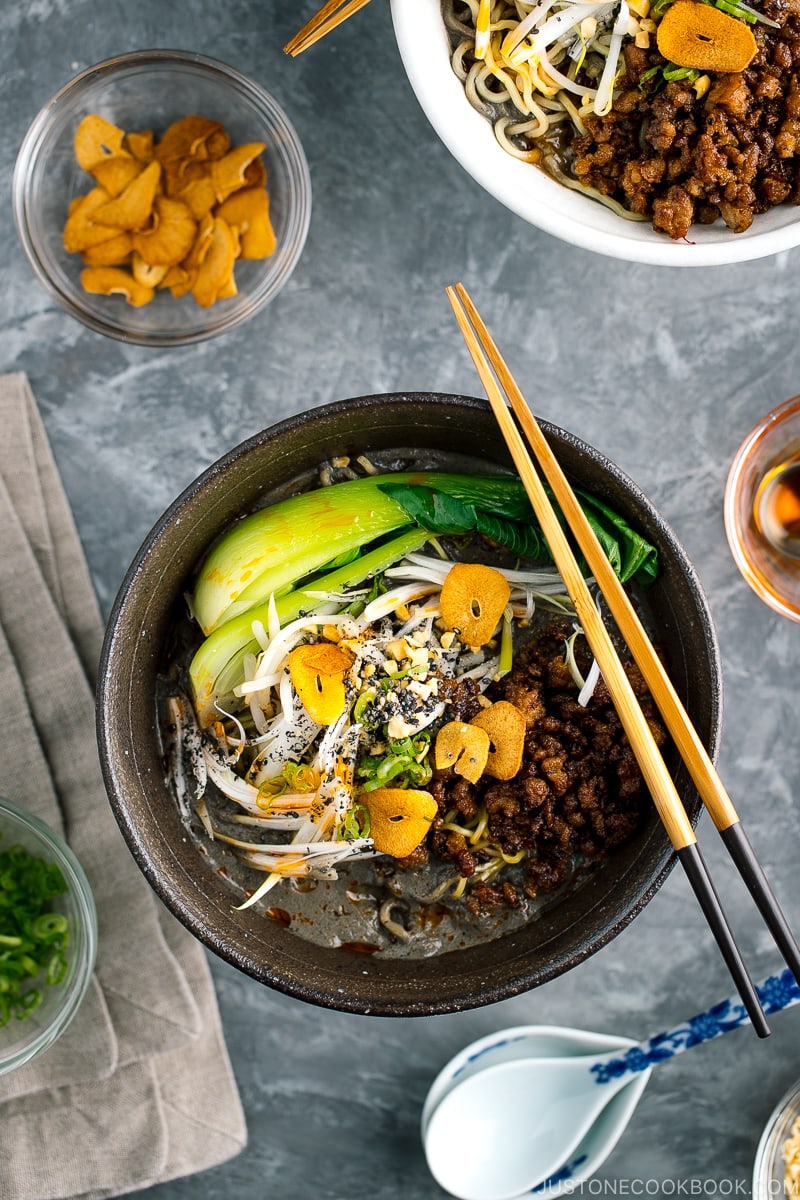
There is a popular Chinese-style restaurant called Double Happiness (ダウブルハピネス) in my neighborhood in Yokohama, Japan. This restaurant specializes in Black Sesame Dan Dan Noodles or Black Sesame Tan Tan Men (黒胡麻担々麺) which we look forward to eating their noodles every year. We’ve tried dan dan noodles at many other restaurants, but we believe theirs is by far the best. The noodles are brilliantly redefined and oh-so-good!
Inspired, I decided to tinker with the recipe and today I’m sharing my version of Black Sesame Tan Tan Men with you. Make this if you want a comforting, yet truly outstanding bowl of noodles!
Inspiration for Black Sesame Dan Dan Noodles
At Double Happiness, Mr. JOC always orders hot black sesame tan tan men (left picture below) while I always order the cold one (right picture). The broth for the hot version is made of black sesame paste, chicken broth, and soy milk, but the cold broth only includes chicken broth and ground black sesame so it’s less creamy. Both are just as mouthwatering as they look.
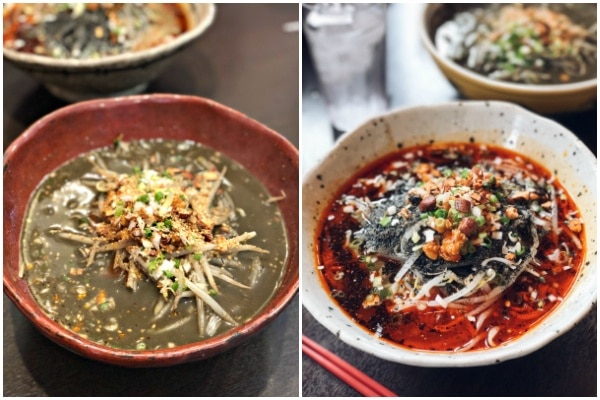
To make an amazing bowl of dan dan noodles, I believe every element plays a role in accomplishing a layered, complex flavor. The perfectly cooked noodles, the savory broth, the meat mixtures, the toppings – each component can make a difference. However, that doesn’t mean you cannot have your own interpretation of the noodle dish.
What distinguishes the Japanese take on this Sichuanese noodle is the addition of soymilk and black sesame paste. The broth is creamier, nuttier, and ultra umami without the numbing sensation of Sichuan peppercorn, hence black sesame dan dan noodles are appealing to anyone who can handle milder heat.
Today I’ve made both hot and cold broths based on Double Happiness’ hot version.
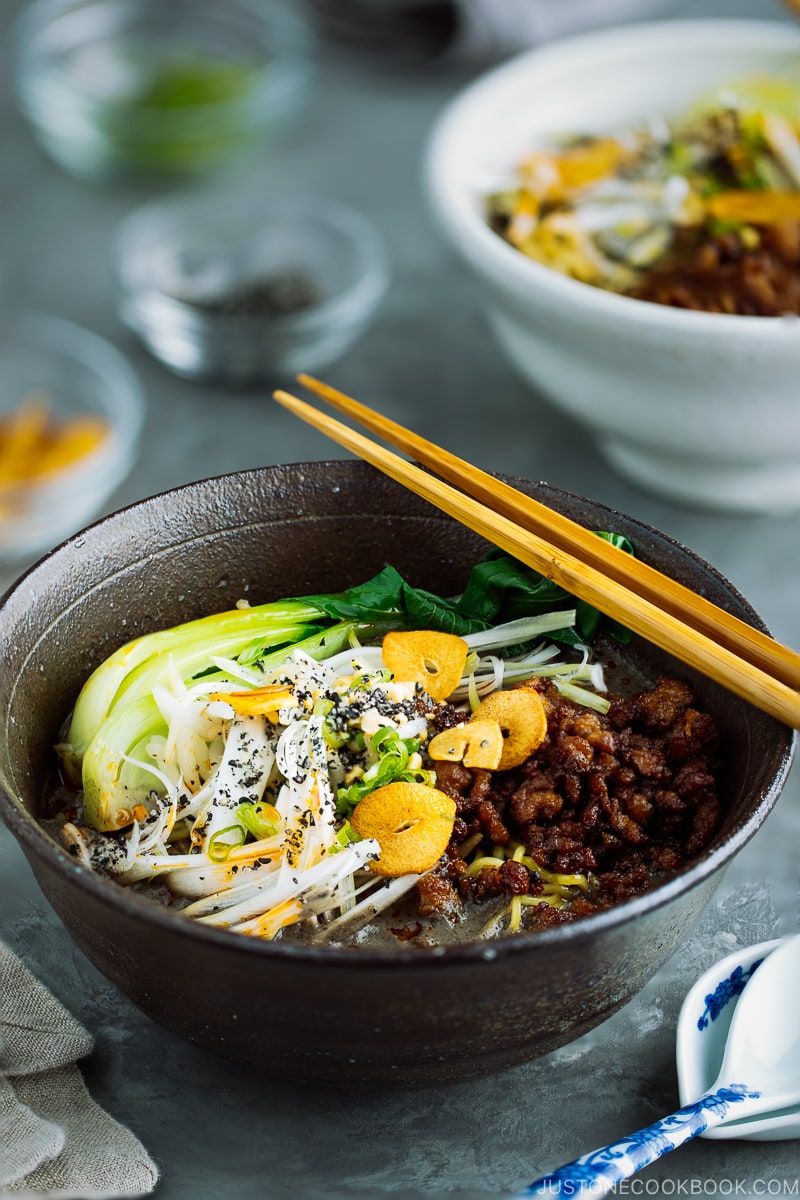
6 Key Ingredients for Black Sesame Dan Dan Noodles
1. Black Sesame Paste
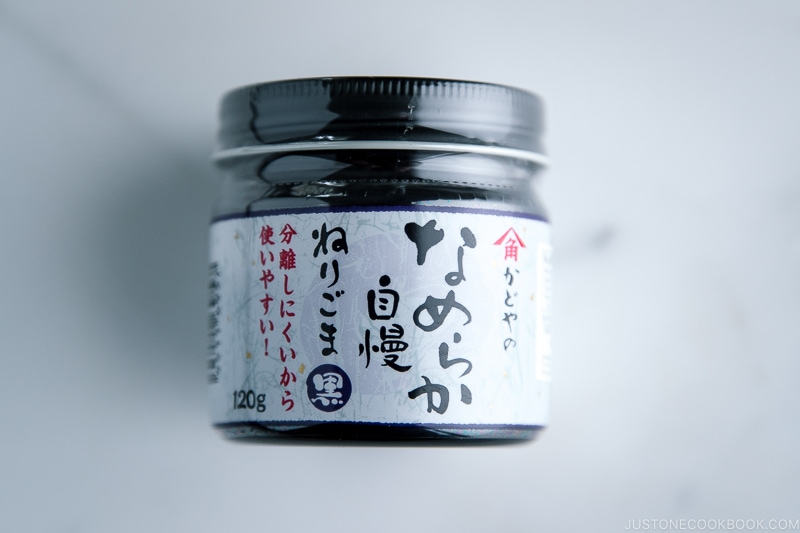
Black sesame paste or Kuro (black) Nerigoma (sesame paste) is 100% unhulled black sesame seeds in a paste form. Some brands may additionally include sesame oil and it is more liquidy. The paste is not sweetened, so we often add honey to sweeten it for black sesame desserts.
The paste in the jar can be found in any Japanese grocery store, but you may have a difficult time finding it at other Asian grocery stores. There are a few brands (Marumoto brand or Jun Kuki brand) available on Amazon, but based on the reviews it looks like the products are shipped from Japan so they may take a month to get to you.
Alternatively, you can use black tahini (Amazon sells this brand). The difference between Japanese sesame paste and tahini is that Japanese sesame paste is made with unhulled sesame seeds and tahini is made with hulled sesame seeds. Japanese sesame paste has a nuttier flavor than tahini because tahini is not roasted as much as Japanese sesame paste.
2. Unsweetened Soymilk

For my savory dishes that use soymilk, I use the unsweetened (original) flavor of soymilk. For the best nutty flavor, I highly recommend using soy milk and not other milk like cow milk or almond milk.
In the US, unsweetened organic soymilk by Silk is widely available at your local grocery stores.
3. Chicken Stock/Broth
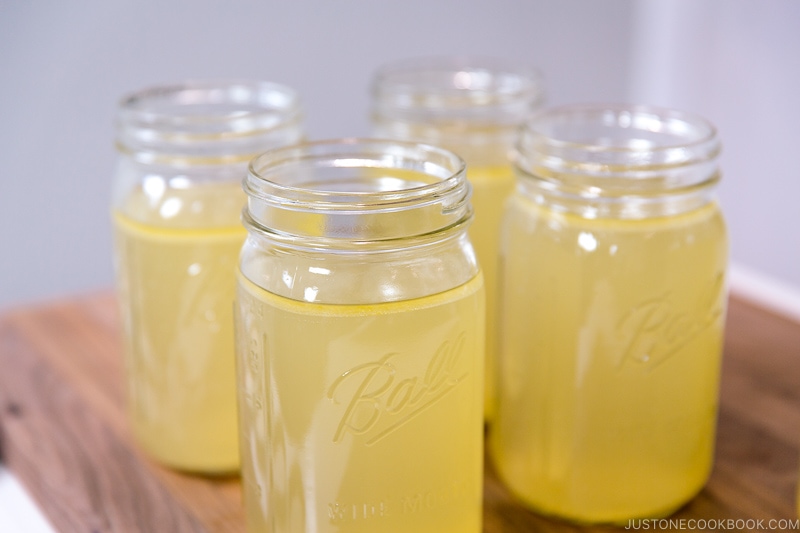
Depending on the brand of chicken stock/broth, the saltiness varies. Please always taste your soup before seasoning with salt. I use kosher salt for all my recipes. If you use table salt, please use half of the portion I specify in the recipes.
If you like to make homemade chicken broth, here’s the recipe.
4. Tianmianjiang (Sweet Bean Paste)
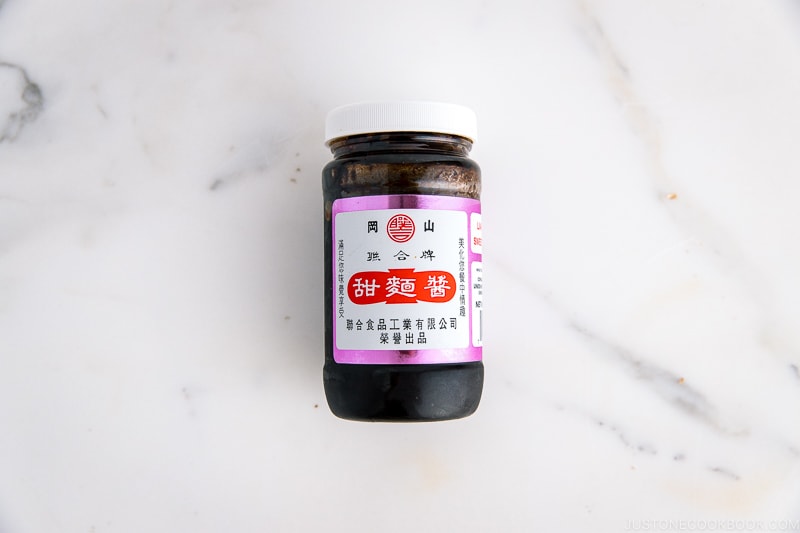
This is a sweet paste of fermented beans. A spoonful of this sweet bean paste adds an incredible depth to the flavor.
I use this jar that’s only written in Chinese. It is locally packed in the Bay Area, but I think it’s a Taiwanese brand. The Chinese characters read 甜麵醬 if you need to check the label.
5. Doubanjiang (Spicy or non-Spicy Broad Bean Paste)
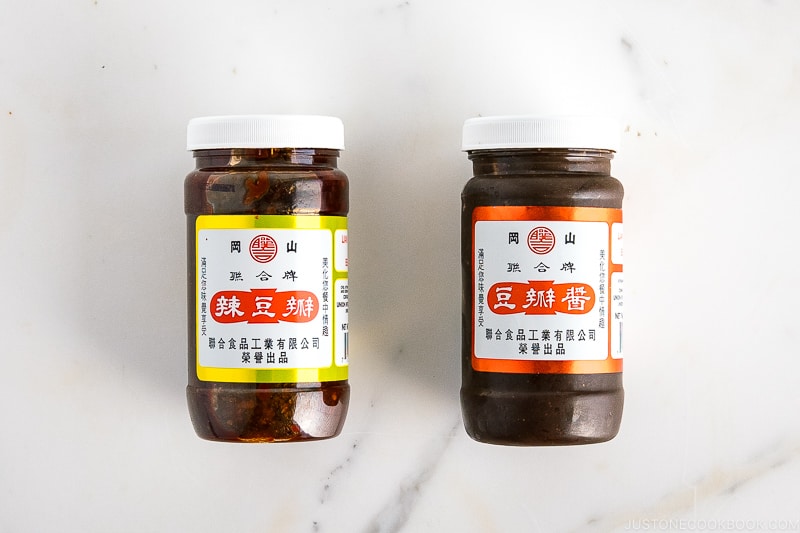
LEE KUM KEE is a popular brand that is widely available in an Asian grocery stores. However, there is only the chili/spicy version (La Doubanjiang). If you can find this Taiwanese 岡山 brand (see the bottles on the right), you can choose spicy or non-spicy doubanjiang. Amazon does not sell the non-spicy version, but you can buy it on Weee! or Walmart.
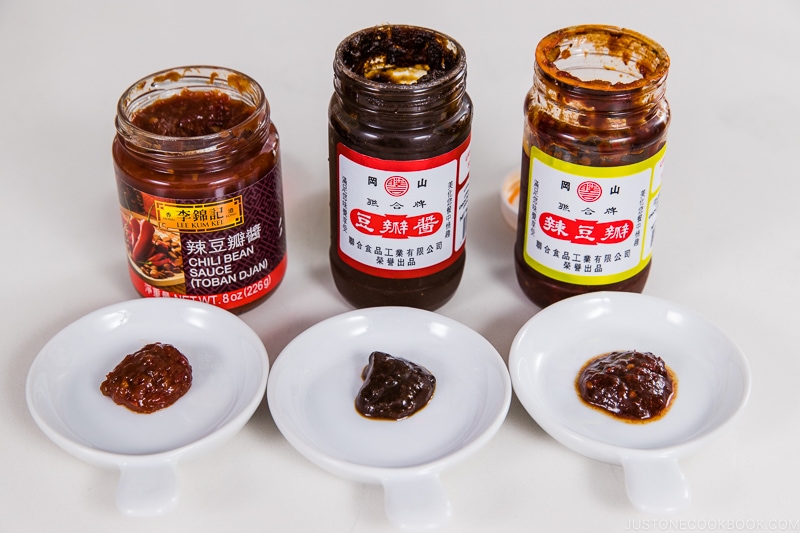
For this recipe, I used LEE KUM KEE brand, but I like to mix spicy and non-spicy doubanjiang with my own ratio (based on kids’ level of tolerance).
6. La-yu (Japanese Chili Oil)

La-yu (ラー油・辣油) is a Japanese chili oil and you may see this small bottle at the table in Japanese restaurants. Although Japanese food is not spicy in general, we sometimes like to drizzle a bit of La-Yu in our dipping sauce (like for Gyoza), noodle soups, and soups.
You can get La-Yu at Japanese grocery stores, Asian grocery stores, or Amazon.
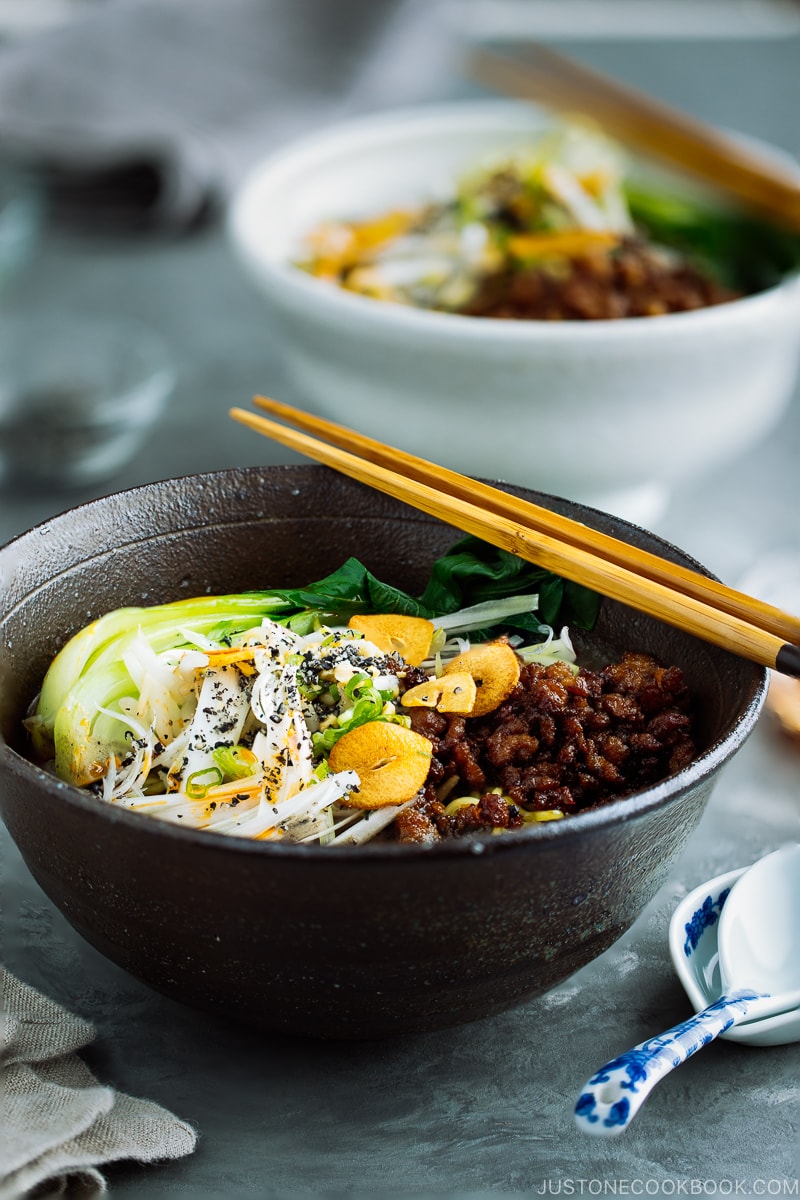
How to Make Fried Garlic Chips
Fried garlic chips may seem like extra work, but they add such an amazing textural crunch and flavor to the black sesame dan dan noodles that I feel something would be missing if you decide to skip it.
To make these garlic chips, you just need to add neutral-flavored oil (vegetable, canola, etc) in a large frying pan and slowly fry the thinly sliced garlic pieces until golden brown. The caveat here is to make sure you don’t heat the oil too fast to prevent burnt garlic slices. Once they are beautifully brown, transfer to a dish lined with a paper towel and keep the garlic-infused oil for other cooking. Feel free to make more and have these garlic chips on hand for your other noodle dishes or rice dishes such as Garlic Fried Rice and Oxtail Udon.
Immersed in an unforgettable broth and adorned with various toppings, I promise this Black Sesame Dan Dan Noodles will satisfy your taste buds, leaving you craving for more.
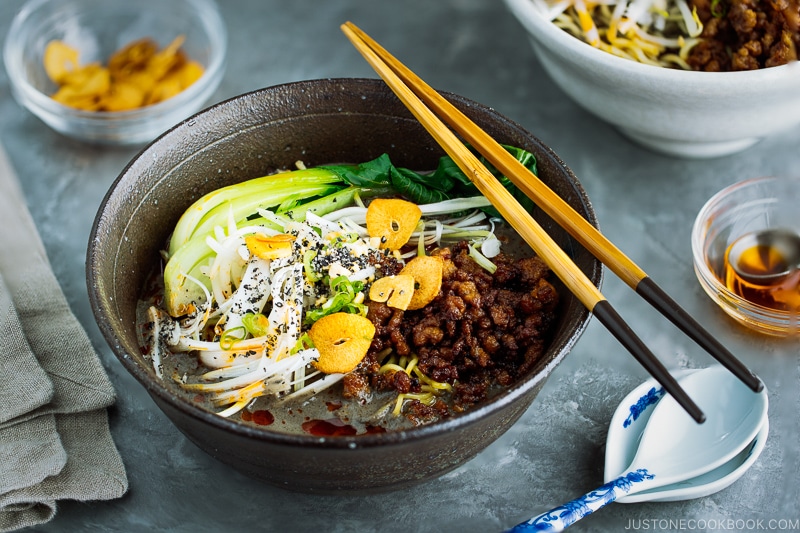
Wish to learn more about Japanese cooking? Sign up for our free newsletter to receive cooking tips & recipe updates! And stay in touch with me on Facebook, Pinterest, YouTube, and Instagram.
Black Sesame Dan Dan Noodles
Ingredients
For the Soup
- ½ cup soy milk
- 1½ Tbsp black sesame paste (you can make homemade Black Sesame Paste; see Notes for substitutions)
- 2 cups chicken stock/broth
- 1 Tbsp rice vinegar (unseasoned)
- 1 Tbsp soy sauce
- 1 tsp sugar
- ½ tsp Diamond Crystal kosher salt (adjust the amount based on your chicken stock’s saltiness)
For the Meat Sauce
- 1 clove garlic
- 1 tsp ginger (grated, with juice; from a 1-inch, 2.5-cm knob)
- 1 Tbsp toasted sesame oil
- 6 oz ground pork
- 1 tsp sake
- ¼ tsp freshly ground black pepper
- 2 tsp tianmianjiang (sweet bean sauce) (or use miso)
- 1 tsp doubanjiang (spicy chili bean paste) (use either the spicy or non-spicy type, or use gluten-free doubanjiang); see Notes)
- 1 tsp soy sauce
- 1 tsp sugar
For the Toppings and Noodles
- 1 Tbsp peanuts (roasted; or use walnuts)
- 1 Tbsp toasted black sesame seeds
- 1 head Shanghai bok choy
- 4 green onions/scallions
- 2 oz bean sprouts (½ cup, 1 handful)
- 12 oz dan dan noodles
- 2 Tbsp fried garlic chips (or more; you can make homemade Garlic Chips)
- 4 tsp la-yu (Japanese chili oil) (or plus more; store bought or make my Homemade La-yu)
Instructions
- Gather all the ingredients.
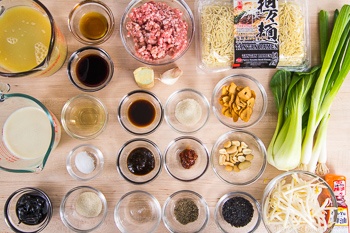
To Make the Soup Broth
- Combine ½ cup soy milk and 1½ Tbsp black sesame paste. Using your silicone spatula, press the black sesame paste against the liquid measuring cup (or bowl) to dissolve the paste.

- Once the paste is dissolved, transfer to the pot and heat up the soup. Add 2 cups chicken stock/broth. NOTE: We like a creamier soup, but if you prefer a thinner soup, add more chicken stock.
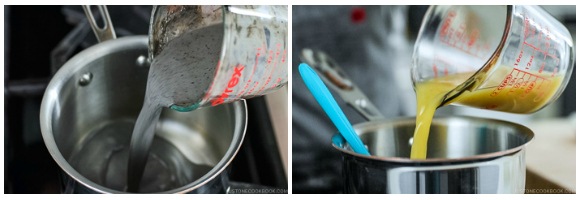
- Add 1 Tbsp rice vinegar (unseasoned), 1 Tbsp soy sauce, and 1 tsp sugar. Increase the amount if you added more chicken stock.

- Mix well and taste the soup. Adjust the amount of kosher salt based on your chicken stock. I added ½ tsp Diamond Crystal kosher salt.

- If you want to have COLD black sesame dan dan noodles, remove the soup from the heat and chill the soup in iced water. Then, refrigerate it until the rest of the ingredients are ready. You can keep it in the refrigerator up to 24 hours. Here, I took half of the soup to chill (for me) and keep the hot soup for Mr. JOC.
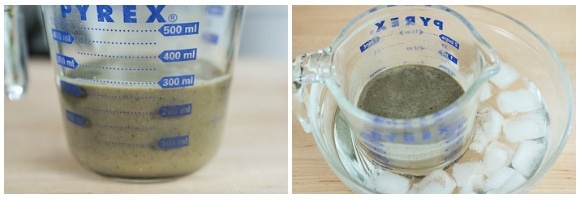
To Make the Meat Sauce
- Grate 1 clove garlic. Grate knob of ginger and measure about 1 tsp ginger (grated, with juice). You don’t have to grate the entire ginger.
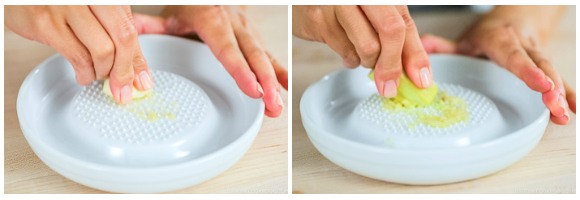
- Heat 1 Tbsp toasted sesame oil over medium heat and cook the grated garlic and ginger until fragrant. Be careful not to burn them.
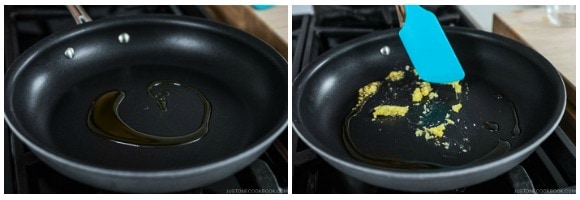
- Add 6 oz ground pork and continue to stir with a spatula and separate the meat.
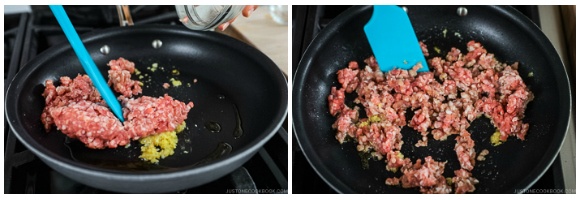
- Add 1 tsp sake and ¼ tsp freshly ground black pepper.
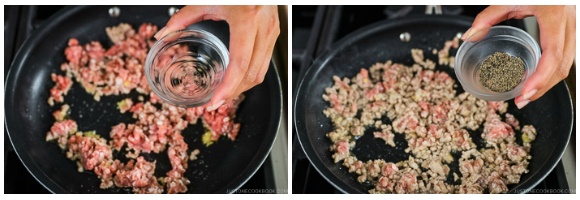
- Add 2 tsp tianmianjiang (sweet bean sauce) and 1 tsp doubanjiang (spicy chili bean paste).
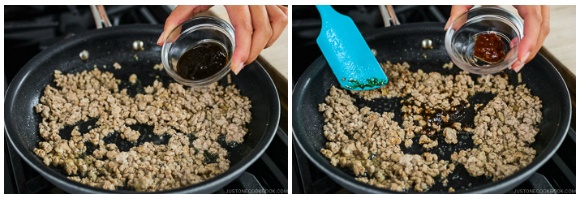
- Add 1 tsp soy sauce and 1 tsp sugar.
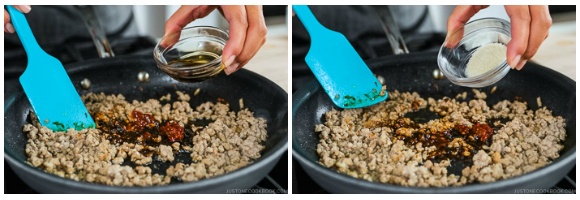
- Stir and coat the meat with the sauce.
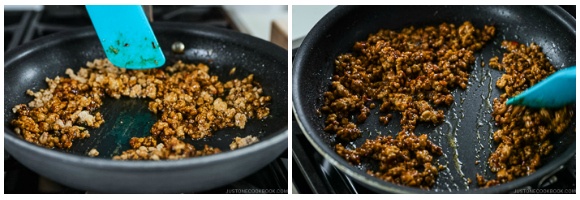
To Prepare the Toppings
- Grind 1 Tbsp peanuts with a amortar and pestle; you could also put the peanuts in a plastic bag and crush them using a rolling pin.
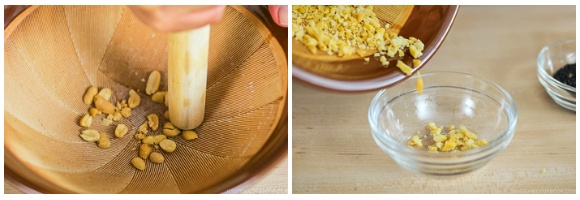
- Grind 1 Tbsp toasted black sesame seeds.
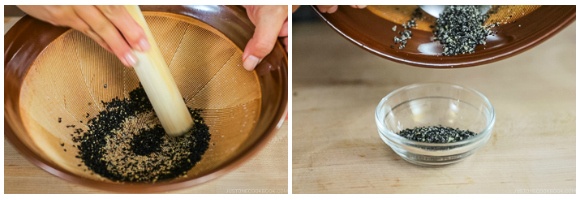
- Cut 1 head Shanghai bok choy into quarters lengthwise.
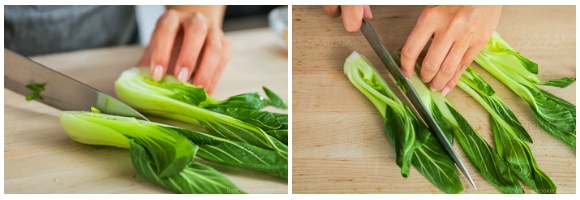
- Cut 4 green onions/scallions in half separating the green and white parts. Cut the white part in half lengthwise and keep the green part for later.
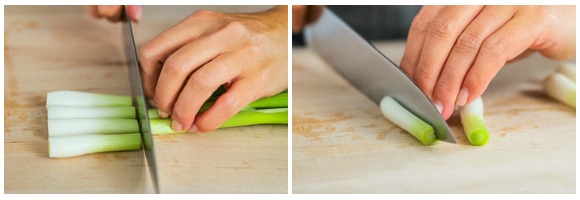
- Cut the white part into julienned strips. Then, soak in iced water for 15 minutes to remove the bitterness and to make it crisp. Drain well and set aside.
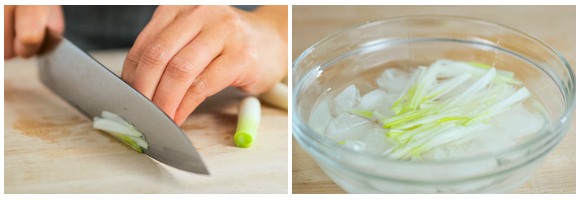
- Chop the green part of the green onion into fine rounds.
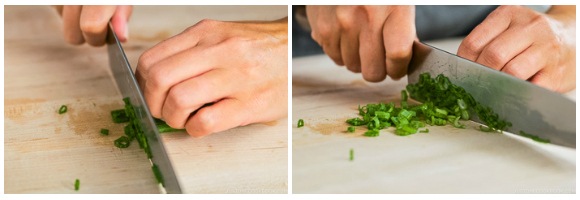
- Bring a pot of water to a boil. Once boiling, add the bok choy first to blanch for 2–3 minutes (depending on its size). Then, add 2 oz bean sprouts. Cook for 10 seconds and remove both the bok choy and bean sprouts from the water to drain completely.

To Assemble
- Cook 12 oz dan dan noodles according to the package instructions. I recommend cooking 15–20 seconds less than what package says, as the remaining heat will continue to cook the noodles.

- To make COLD dan dan noodles: Soak the noodles in iced water until chilled and drain completely. Transfer the noodles to a large bowl and pour in the chilled black sesame soup.

- Place the bok choy, bean sprouts, and meat sauce on top of the noodles.
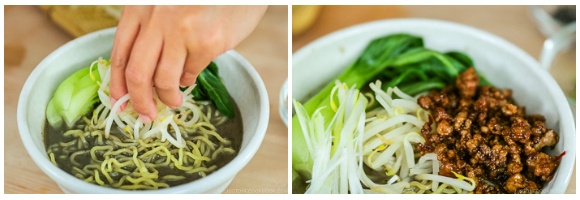
- Garnish with peanuts, black sesame seeds, the white part of the green onion, and 1 Tbsp garlic chips, and drizzle with 2 tsp la-yu (Japanese chili oil). The COLD dan dan noodle is ready to serve.
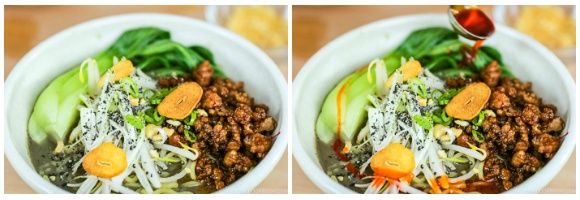
- To make HOT dan dan noodles: Serve the hot noodles in a large bowl and pour in the hot black sesame soup. Place the bok choy, bean sprouts, and meat sauce on top of the noodles.
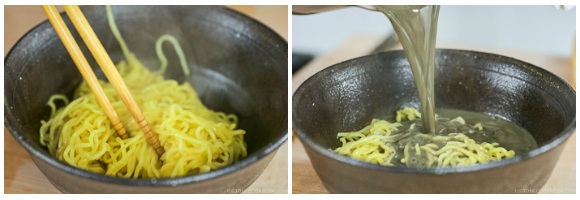
- Garnish with peanuts, black sesame seeds, the white part of the green onion, and 1 Tbsp garlic chips, and drizzle with 2 tsp la-yu (Japanese chili oil). Enjoy!
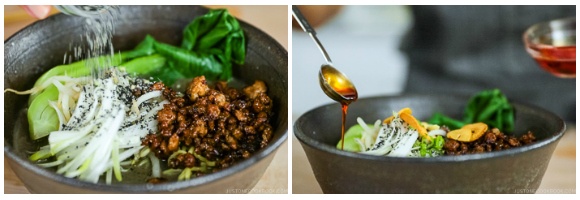
Notes
- Black sesame paste: You can purchase black sesame paste at any Japanese grocery store or on Amazon (Marumoto brand or Jun Kuki brand). It’s less flavorful, but you can use tahini (this brand) on Amazon.
- Doubanjiang (spicy chili bean sauce/broad bean paste): You can buy non-spicy version online.
Nutrition
Did you make this recipe?
Tag @justonecookbook on Instagram so we can see your delicious creation!


